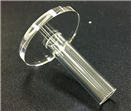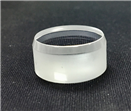

Time:2024-04-12
Sapphire is made of aluminum oxide (Al2O3), and the advantages of processing services make it a popular choice for various applications that require high strength, optical transparency, and chemical resistance. Usually used as gemstones or for industrial applications, and can exhibit reflective properties. However, their reflectivity depends on several factors, including surface smoothness, incident angle of light, and wavelength of light. Generally speaking, sapphire lenses have a relatively high refractive index, which means they can bend and slow down the light passing through, causing light to reflect off their surface. This characteristic endows sapphire with corresponding luster and radiance, and is commonly used in gemstone jewelry. However, sapphires can also be transparent, allowing light to pass through them without significant reflection.

The reflectivity of sapphire also varies depending on the surface finish. If the sapphire lens surface is highly polished and smooth, it can exhibit higher reflectivity, while rough or textured surfaces may scatter light, resulting in lower reflectivity. In addition, the reflectivity also depends on the incident angle of light. When light shines on the surface of sapphire at a specific angle (known as the critical angle), total internal reflection occurs, causing the light to bounce back and reflect off the surface with minimal intensity loss. This phenomenon is often utilized in optical applications, such as sapphire windows used in high-pressure chambers or optical lenses.
Sapphire lenses can exhibit reflective properties, but the level of reflectivity depends on various factors such as surface finish, incident angle of light, and wavelength of light. The range varies from high reflectivity to transparency, depending on these factors and their usage in different applications. The reflectivity of sapphire also depends on the wavelength of light, and it can exhibit different reflectivity at different wavelengths, with some reflections being stronger than others.






Tel
Mobile phone
Customer service
TOP